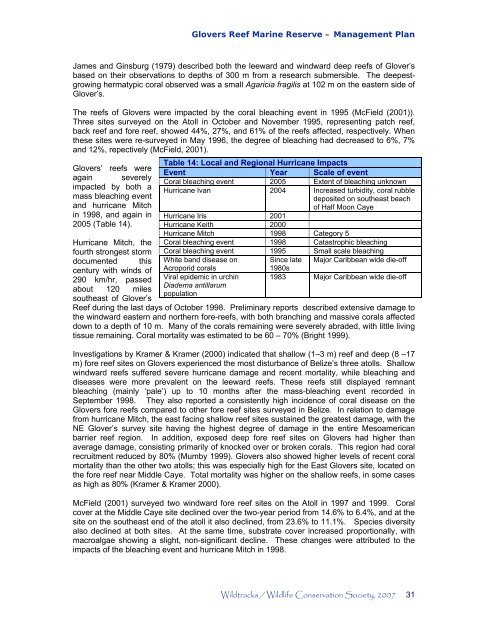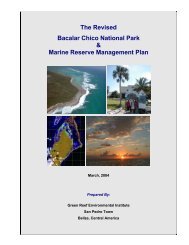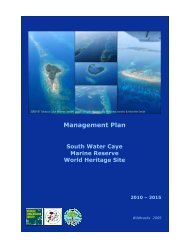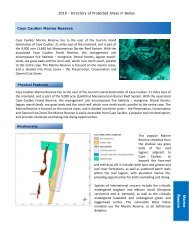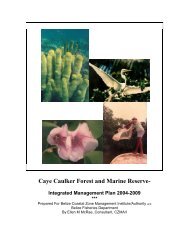Management Plan - Glover's Reef Marine Reserve
Management Plan - Glover's Reef Marine Reserve
Management Plan - Glover's Reef Marine Reserve
You also want an ePaper? Increase the reach of your titles
YUMPU automatically turns print PDFs into web optimized ePapers that Google loves.
Glovers <strong>Reef</strong> <strong>Marine</strong> <strong>Reserve</strong> – <strong>Management</strong> <strong>Plan</strong><br />
James and Ginsburg (1979) described both the leeward and windward deep reefs of Glover’s<br />
based on their observations to depths of 300 m from a research submersible. The deepestgrowing<br />
hermatypic coral observed was a small Agaricia fragilis at 102 m on the eastern side of<br />
Glover’s.<br />
The reefs of Glovers were impacted by the coral bleaching event in 1995 (McField (2001)).<br />
Three sites surveyed on the Atoll in October and November 1995, representing patch reef,<br />
back reef and fore reef, showed 44%, 27%, and 61% of the reefs affected, respectively. When<br />
these sites were re-surveyed in May 1996, the degree of bleaching had decreased to 6%, 7%<br />
and 12%, repectively (McField, 2001).<br />
Glovers’ reefs were<br />
again severely<br />
impacted by both a<br />
mass bleaching event<br />
and hurricane Mitch<br />
in 1998, and again in<br />
2005 (Table 14).<br />
Hurricane Mitch, the<br />
fourth strongest storm<br />
documented this<br />
century with winds of<br />
290 km/hr, passed<br />
about 120 miles<br />
southeast of Glover’s<br />
Table 14: Local and Regional Hurricane Impacts<br />
Event Year Scale of event<br />
Coral bleaching event 2005 Extent of bleaching unknown<br />
Hurricane Ivan 2004 Increased turbidity, coral rubble<br />
deposited on southeast beach<br />
of Half Moon Caye<br />
Hurricane Iris 2001<br />
Hurricane Keith 2000<br />
Hurricane Mitch 1998 Category 5<br />
Coral bleaching event 1998 Catastrophic bleaching<br />
Coral bleaching event 1995 Small scale bleaching<br />
White band disease on Since late Major Caribbean wide die-off<br />
Acroporid corals<br />
Viral epidemic in urchin<br />
Diadema antillarum<br />
population<br />
1980s<br />
1983 Major Caribbean wide die-off<br />
<strong>Reef</strong> during the last days of October 1998. Preliminary reports described extensive damage to<br />
the windward eastern and northern fore-reefs, with both branching and massive corals affected<br />
down to a depth of 10 m. Many of the corals remaining were severely abraded, with little living<br />
tissue remaining. Coral mortality was estimated to be 60 – 70% (Bright 1999).<br />
Investigations by Kramer & Kramer (2000) indicated that shallow (1–3 m) reef and deep (8 –17<br />
m) fore reef sites on Glovers experienced the most disturbance of Belize’s three atolls. Shallow<br />
windward reefs suffered severe hurricane damage and recent mortality, while bleaching and<br />
diseases were more prevalent on the leeward reefs. These reefs still displayed remnant<br />
bleaching (mainly ‘pale’) up to 10 months after the mass-bleaching event recorded in<br />
September 1998. They also reported a consistently high incidence of coral disease on the<br />
Glovers fore reefs compared to other fore reef sites surveyed in Belize. In relation to damage<br />
from hurricane Mitch, the east facing shallow reef sites sustained the greatest damage, with the<br />
NE Glover’s survey site having the highest degree of damage in the entire Mesoamerican<br />
barrier reef region. In addition, exposed deep fore reef sites on Glovers had higher than<br />
average damage, consisting primarily of knocked over or broken corals. This region had coral<br />
recruitment reduced by 80% (Mumby 1999). Glovers also showed higher levels of recent coral<br />
mortality than the other two atolls; this was especially high for the East Glovers site, located on<br />
the fore reef near Middle Caye. Total mortality was higher on the shallow reefs, in some cases<br />
as high as 80% (Kramer & Kramer 2000).<br />
McField (2001) surveyed two windward fore reef sites on the Atoll in 1997 and 1999. Coral<br />
cover at the Middle Caye site declined over the two-year period from 14.6% to 6.4%, and at the<br />
site on the southeast end of the atoll it also declined, from 23.6% to 11.1%. Species diversity<br />
also declined at both sites. At the same time, substrate cover increased proportionally, with<br />
macroalgae showing a slight, non-significant decline. These changes were attributed to the<br />
impacts of the bleaching event and hurricane Mitch in 1998.<br />
Wildtracks / Wildlife Conservation Society, 2007 31


